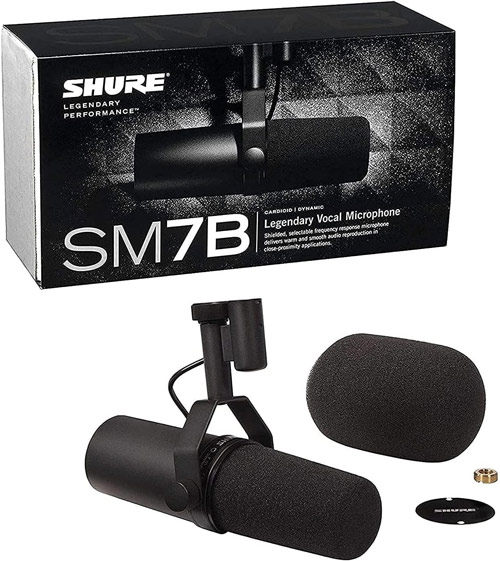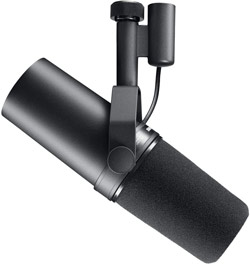
This is the microphone that you see many podcasters, YouTubers, twitch streamers, and radio shows use. This is the mic that many people go to when they want to upgrade from their basic setup to better production quality.
It costs $400 (and probably ~$100+ more on gear to boost the signal). Is it worth it? In my opinion: It’s a good mic but it’s not for everyone.
It has a low gain sensitivity. This means it needs a lot of gain to get the volume at an acceptable level; many audio interface boxes aren’t enough by themselves. You need some kind of beefy pre-amp or a signal booster device (i.e. a Cloudlifter).
The design is intuitive. The capsule is buried deep into the mic so you don’t speak too close to it. It comes with wind foam built in to block plosives. It comes with a swivel to adjust the mic to face your mouth. It’s convenient and idiot-proof. But keep in mind, you can do these things on any mic with a pop filter, a decent microphone mount, and proper recording technique.
The sound. It’s mostly flat/neutral. The frequency response graph shows a boost at 5-6k and a slight cut at 7-8k. I’d subjectively describe the sound as dampened, grounded, calm, somewhat serious. There is a subjectivity to tone. Just because a mic is $400 doesn’t mean that it will sound better than a $100 mic on every single person. Some people may prefer a more brighter and animated sound. Personally, I own the SM7B and I like it, but it’s not in the top 5 mics I use the most often.
SM7B is not a solution to a bad recording environment. It will not remove background noise or reflections on walls/hard surfaces. This may not be what you want to hear – people want the magical product that will fix the problems – but this is the cold hard truth. No mic will fix a bad room. To get better sound quality, you need to fix the room itself first.
To get good recordings:
- The room shouldn’t be too small and the mic shouldn’t be too close to the wall (at least 2-3 feet away). Get a stand for the mic that lets you put it where you want it.
- The room should have treatment (i.e. foam, acoustic panels, maybe a diffuser). If you have pillows, blankets or blackout curtains, those can help too.
- You need to record in an area with low noise. You need to find some way to reduce the noise. Or maybe something to insulate your door and window from outside noise.
There is also the claim that the SM7B is great for loud vocals because the mic doesn’t get too loud to where it distorts, but keep in mind you can scream on any mic as loud as you want if you set the gain knob low enough.
Regarding the cost. If you already have a great recording environment and a studio setup, and have the money to spend, go for it. But if you’re just starting out and you have a limited budget, there are more important places to spend money.
If I were newer to audio, I would buy a good $100 mic and spend the rest on sound treatment.
There are many great <$100 mics out there. MXL has some good ones (i.e. V67G). Behringer C1. Sterling ST55 if you want a neutral tone. A point I want to emphasize is that your recording environment and recording technique are 10x more important than the mic you buy.
